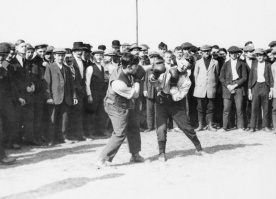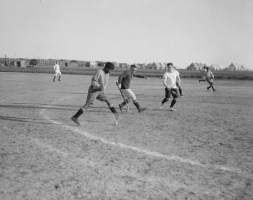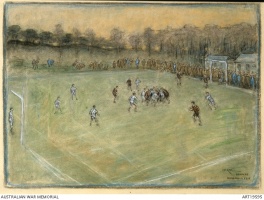Introduction↑
Before the soldiers of the Central Powers and the Allies were sent to war, they were prepared militarily and physically for military service in professional armies. Physical education in their home countries included gymnastics and sports such as athletics, swimming, and ball games, in particular football, rugby, and American football – the latter ball games were practiced mainly in the United Kingdom and the United States.
But even in the German Reich, where physical education traditionally was characterized by gymnastics (Turnen) the military – on the advice of the DRAfOS (Deutscher Reichsausschuss für Olympische Spiele) – was convinced that the pursuit of individual sporting excellence should be part of the soldier’s training. Even football – rejected as the so-called “English disease“ by the German gymnasts for a long time – had become part of the military’s sport program because of its popularity among young men.
For civilian sports in the war nations, the outbreak of World War I on 28 July 1914 meant a decisive turning point as millions of young men that were sent to the front were absent from their home sport clubs. Therefore, especially in Germany, more and more teenagers joined adult sport teams and at the same time, a militarization of the sporting competitions took place in order to increase the defense force of the future soldiers.
Soldiers Sporting Activities during World War I↑
With the advance of the armies at the beginning of the war, there were fewer chances for soldiers to practice sports. However, the transition of the war into a battle of attrition on the Western Front at the end of 1914 did not only mean grueling fighting from the trench lines, but also increasing possibilities for the soldiers to do sports behind the lines during their combat breaks. Competitions in athletics as well as in swimming and also tennis matches meant a welcome change from the fighting as the course of the war progressed. Football became particularly popular on both sides of the war, including on the Eastern Front, as long as the climate allowed it. On the Western Front, during the "Christmas Truce" of 1914, which was proclaimed by British and German soldiers on their own initiative, there were even improvised football games between the war opponents.
The French soldiers came into contact with football – a new sport for the most of them – through their British allies. In addition, they became acquainted with rugby as well as American football, baseball and basketball after the USA entered the war in 1917. While preparation for military service in France had traditionally taken place with the help of gymnastic exercises, young French men now came increasingly into contact with a new culture of sport based on team spirit, playfulness, and the will to take individual initiative. Furthermore, learning about English-American sports meant getting in contact with the new male role model of a soldier-athlete.
The sport enthusiasm of the soldiers of the Central Powers and the Allies, which, especially on the Western Front led to the establishment of a regulated competition and league system behind the battle lines, was viewed with ambivalence by the commanders in chief. On the one hand, sport was welcomed as a contribution to the preservation of physical fitness and the strengthening of military morale. On the other hand, however, there was the danger of soldiers focusing more on sport than on the war.
In captivity, however, the soldiers had greater opportunities to enjoy sport. In the prisoner of war camps of both the Central Powers and the Allies regular, specially organized sports competitions were held in addition to the daily sporting activities, sometimes even referred to by the prisoners of war as "Olympic Games". In this context, a special feature for the development of sport in Germany is the British internment camp in Knockaloe on the Isle of Man. Here, thousands of interned members of the Central Powers came in contact with boxing – hitherto hardly common in Germany – during World War I. This was where the boxing enthusiasm during the Weimar Republic period began.
Conclusion↑
The soldiers’ enthusiastic embrace of sport during World War I can be understood as a desire to flee from the grueling hostilities and the experience of unimaginable suffering. But at the same time, millions of young men from different countries became so enthusiastic about competitive sports – especially football – that a large number of survivors continued to indulge in their passion even after the end of the war: About 1,500 former soldiers of the Entente took part in the "Inter-Allied Games", which took place in Paris as a multi-sport event from 22 June to 6 July 1919. At the first Olympic Games after World War I 1920 in Antwerp – due to the war, the 1916 Olympic Games which had been awarded to Berlin in 1912, could not take place – more than 2,500 athletes competed in sport competitions. Due to ideological reasons, the newly established Russian Soviet Republic did not take part in Antwerp. Neither did the Germans, who, as a consequence of World War I were excluded from the Olympic Games until 1928. But the newly won love of competitive sports in the context of a large multi-sports event survived in Germany. With the Deutsche Kampfspiele, national Olympic Games were launched in 1922. The event was also held in 1926 and 1930 – both as a winter and summer games.
Ansgar Molzberger, Deutsche Sporthochschule Köln
Section Editor: Emmanuelle Cronier
Selected Bibliography
- Eisenberg, Christiane: 'English Sports' und deutsche Bürger. Eine Gesellschaftsgeschichte 1800-1939, Paderborn 1999: Ferdinand Schöningh.
- Fuller, J. G.: Troop morale and popular culture in the British and Dominion armies, 1914-1918, Oxford 1990: Oxford University Press.
- Kohr, Knud / Krauß, Martin: Kampftage. Die Geschichte des deutschen Berufsboxens, Göttingen 2000: Verlag Die Werkstatt.
- Kunz, Christian; Kluge, Volker: Behind barbed wire. The 'Olympic' Games of 1918, in: Journal of Olympic History 26/2, 2018, pp. 62-67.
- Tauber, Peter: Vom Schützengraben auf den grünen Rasen. Der Erste Weltkrieg und die Entwicklung des Sports in Deutschland, Münster 2008: LIT.
- Terret, Thierry / Mangan, James Anthony (eds.): Sport, militarism and the Great War. Martial manliness and armageddon, London; New York 2012: Routledge.












